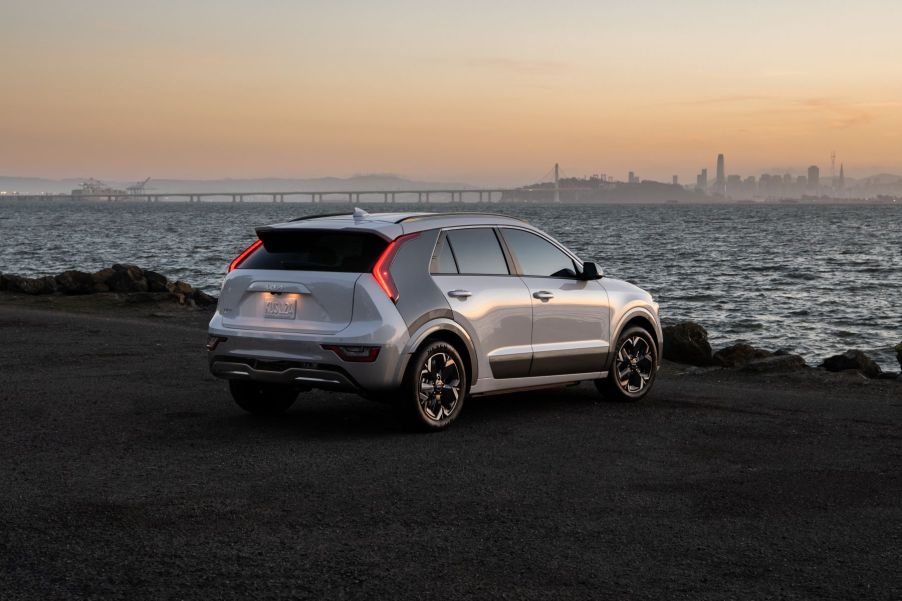
5 Advantages the 2023 Kia Niro EV Has Over the 2023 Hyundai Ioniq 5
When Kia recently redesigned the Niro for the 2023 model year, it made sure to give all three of its versions—the hybrid, plug-in hybrid (PHEV), and electric vehicle (EV)—a makeover. The new Niro is longer, wider, and taller than its previous design, giving it a more aggressive stance. The 2023 Kia Niro EV also has some pretty significant changes under the hood. So, how does it stack up against its main competitor, the 2023 Hyundai Ioniq 5? Here are five reasons to consider the 2023 Kia Niro EV over the 2023 Hyundai Ioniq 5.
1. The Kia Niro EV is more affordable than the Hyundai Ioniq 5
According to Kia Media, the all-new 2023 Kia Niro EV comes in two trims—the EX and the SX. The EX has an MSRP of $39,450, while the SX starts at $44,450. In contrast, the 2023 Hyundai Ioniq 5 has a starting MSRP of $41,450. That’s a difference of $2,000 in favor of the Niro EV, which makes it an ideal choice for budget-minded buyers.
2. The Niro EV has more standard driving range
With a standard 64.8 kWh battery, the 2023 Kia Niro EV has a driving range of up to 253 miles on a single charge. That’s 33 miles more than the 2023 Hyundai Ioniq 5, which has a standard 58 kWh battery pack and 220 miles of driving range when fully charged. Both offer a DC-fast charge option, which can charge the battery from 10% capacity to 80% in about 45 minutes. However, when temperatures drop below freezing, the Ioniq 5’s range can drop by up to 20%. At the same time, the Niro EV is unaffected, thanks to a heating system and winter driving mode that optimizes battery performance.
3. The more energy-efficient option is the Niro EV

The new 2023 Niro EV long-range battery pack and front-wheel-drive system give it an EPA-estimated fuel economy rating of 113 MPGe. Meanwhile, the Ioniq 5 channels its power to the rear wheels, resulting in a slightly lower fuel economy rating of 110 MPGe. Adding an all-wheel drive (AWD) system is an option on the Ioniq 5, but its EPA ratings then drop to 101 MPGe. Kia Niro EV buyers don’t have to worry about that, as the Niro EV comes standard with front-wheel drive.
4. The Hyundai Ioniq 5 trails in horsepower
Regarding performance, the baseline 2023 Kia Niro EV has an advantage over the Ioniq 5 thanks to its all-electric powertrain, which produces 201 horsepower. It is also more powerful than the brand’s 139-hp hybrid and 180-hp plug-in hybrid models. According to Car and Driver, the 2023 Hyundai Ioniq 5 features an all-electric powertrain with multiple output options. The base model paired with a single, rear-mounted electric motor produces 168 horsepower, while the top-of-the-line twin-motor setup delivers 225 horsepower. Additionally, the Niro EV feels more agile and robust to accelerate from 0 to 60 mph in just 6.7 seconds. That’s almost a full second quicker than the Ioniq 5, which needs 7.4 seconds to reach 60 mph.
5. The Niro EV has more cargo space than the Ioniq 5
More room for you and your stuff is an aspect most buyers overlook when choosing an electric vehicle. However, it should be one of the main deciding factors, especially if you often carry a lot of gear. That’s where the 2023 Kia Niro EV shines. With the seats in place, it offers a generous 22.3 cubic feet of cargo space. That’s more than what you’ll get in the Ioniq 5, which only has 19.9 cubic feet of space behind the rear seats. Still, if you require even more room from your Niro EV, simply fold down the 60/40-split rear seats, and you’ll have a whopping 63.7 cu. ft. of storage at your disposal—that’s almost 4 cu. ft. more than the Ioniq 5’s 60.2 cu. ft. of maximum capacity.
When it comes to electric vehicles, the new 2023 Kia Niro EV is a great choice and offers more value than its main competitor, the 2023 Hyundai Ioniq 5. Thanks to its standard long-range battery pack, generous cargo space, and competitive pricing, the Niro EV is a solid option for budget-minded buyers looking for an electric SUV.


